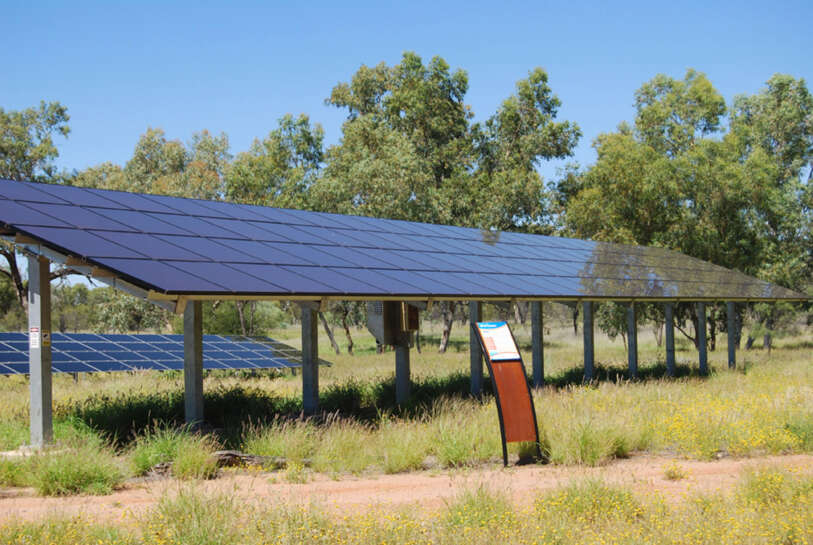| Manufacturer | Kaneka |
|---|---|
| Array Rating | 6kW |
| PV Technology | Other |
| Array Structure | Fixed: Ground Mount |
| Installed | 2008 |
View on Map Graphs Download Data
Current Output

Amorphous silicon thin-film array, fixed ground-mountAmorphous silicon panels are a thin-film technology, made with a layer of photovoltaic material applied to the panel’s substrate. They contain less silicon than crystalline panels, which can lower costs.
The manufacture of these panels is highly automated – silicon is deposited as a gas on a substrate like glass.
Another advantage of reducing the silicon used in a solar panel is that it takes less time for the panel’s output to match the energy used in its construction – its energy payback time. Silicon has a high amount of energy associated with its production.
Thin-film panels are not as sensitive to partial shading as crystalline panels. Their layer of photovoltaic material allows more flexibility in the layout of the electrical contacts. The long horizontal cells across the panel make them less susceptible from being blocked by shade.
Thin-film panels are less efficient than crystalline panels, and a greater number is required for a given output. However, their output is less affected by heat.
MPower (formerly M+H Power Systems) is an Australian company supplying renewable energy products, including Kaneka amorphous panels manufactured in Japan.
| Array Rating | 6kW |
|---|---|
| Panel Rating | 60W |
| Number Of Panels | 100 |
| Panel Type | Kaneka G-EA060 |
| Array Area | 95.04 m² |
| Type Of Tracker | N/A |
| Inverter Size / Type | 6 kW Fronius Primo Replaced 6 kW, SMA SMC 6000A on 29/4/22 |
| Installation Completed | Tue, 11 Nov 2008 |
| Array Tilt/Azimuth | Tilt = 20, Azi = 0 (Solar North) |

Notes on the Data
-
Inverters replaced
Failed inverters on sites 8,32,33 and 34 have been replaced with Fronius Primo 6kW inverters. These systems are now generating normally again.
-
System Disconnection for Cabling Works
All arrays at the Solar Centre were disconnected from approximately 2.00pm to 3.00pm on Monday, 9 July 2018 in preparation for the cable between the main switchboard and distribution board being upgraded. Array sites #23-38 remained disconnected while the main feeder cable to these sites was replaced in subsequent days, but all systems were re-connected by early afternoon on Thursday, 12 July 2018.
-
Monitoring Interruption for UPS Battery Replacement
The disconnection and re-connection of the solar arrays and weather station equipment while a new site connection was being established prompted the already flattening UPS batteries which power the site’s energy meters to fail and require immediate replacement. Data recording was affected from approximately 2.30pm ACST, Monday 10 July to 4.00pm, Wednesday 12 July.
Affects weather data for DKASC, Alice Springs
> Answer to Spotlight Question
Onsite at the DKA Solar Centre in Alice Springs are a series of quiz-like Spotlight Questions at each array. Visit the centre and scan the QR code at each sign to test your knowledge – and check your answer here!
Q: Why is this array so much bigger than its neighbours?
A: Thin film solar modules tend to be less efficient than crystalline varieties, requiring more surface area to produce the same amount of electricity due to the nature of the photovoltaic cell. Out of the three most common thin film varieties, those using the chemistry of amorphous silicon are even less efficient than rivals CIGS and CdTe. This amorphous silicon array (#8, 2008) has an efficiency of 0.063 kW/sqm while its neighbours have 0.069 kW/sqm (#9, 2009 CIGS) and 0.101 kW/sqm (#7, 2008 CdTe) respectively. By comparison, crystalline types (and some modern thin films) often achieve efficiencies on the order of 0.1-0.2 kW/sqm. Although thin film PV modules are significantly less efficient than their crystalline cousins, they are significantly cheaper to manufacture.
